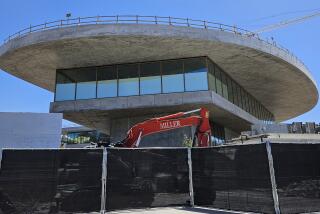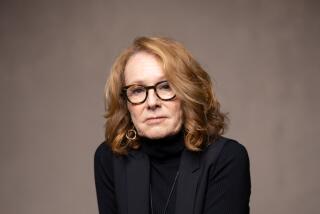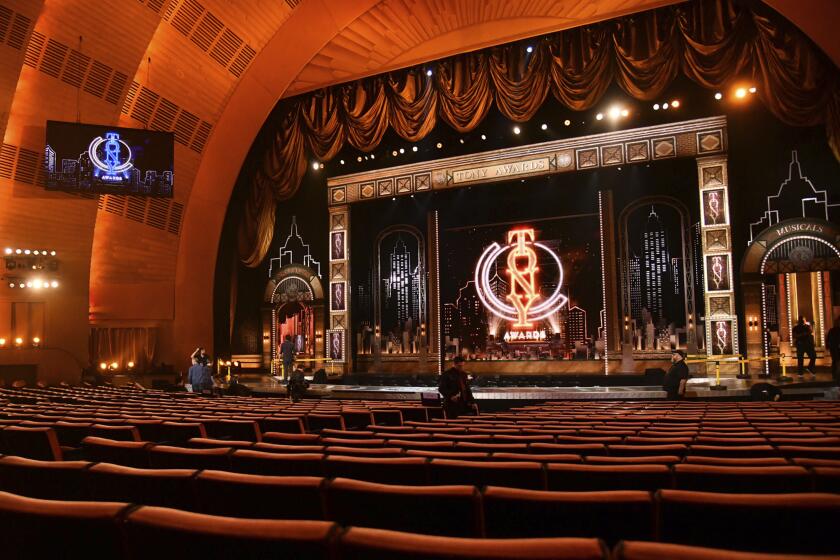A Museum With an Image Problem? : Controversy: A recent series of stumbles--real or perceived--by Newport Harbor may be seriously impeding the respected institution’s search for a new director.
- Share via
The Newport Harbor Art Museum took an unusual step for conservative Orange County last week in choosing to take the National Endowment for the Arts to court.
Consider the general climate for arts in Orange County in recent months:
* As the nationwide furor over freedom of expression and the NEA raged, at the local level a nude photograph of John Lennon was yanked from a Fullerton exhibition in April, then reinstated after drawing national attention.
* Earlier this month, a plan to reproduce a painting for a poster commemorating expansion of the county’s major airport was quashed after one airport official objected to the picture’s nudity.
* Most recently, a handful of irate Costa Mesa residents condemned a community theater production of Christopher Durang’s 1979 satire “Sister Mary Ignatius Explains It All For You” as “anti-religious bigotry” that shouldn’t get one cent of city arts money.
Nevertheless, the Newport Beach museum called a high-profile news conference to announce its suit against the NEA over its controversial anti-obscenity certification, which some critics have likened to a McCarthy-era loyalty oath. Believing that a court will strike down the NEA’s requirement that 1990 grant recipients pledge that funds won’t be used to produce or present obscene works, the institution became the nation’s first museum and only the third organization to file a federal suit over the matter.
The move, which museum officials said is intended to free the NEA from the controversial grant restriction while not undermining the federal agency itself, drew many accolades in the arts community.
Yet one museum-community professional, who requested anonymity, said the museum’s suit could be viewed as a ploy “to get them some good ink.” In the museum’s defense, the source added, “You could also say, ‘Gee, they’ve not only taken a liberal and progressive stance, but they’ve done something about it.’ ”
Newport Harbor officials proclaimed that it placed them squarely “in the mainstream of the American arts community,” where numerous institutions have opposed the NEA funding restriction.
Behind the news conferences and lofty pronouncements, however, lurks the possibility that the museum is in real need of an image boost. Now more than a year without a director, the small but nationally respected 27-year-old institution has encountered a series of potentially troubling events in the past year, some of which may be seriously impeding its search for new leadership.
While some art-world officials dismiss these developments as something that happens to any major organization at some point in its growth, others express fear that the void at the top could result in the corporate co-opting of Orange County’s most adventuresome art institution.
The first plateau in the museum’s remarkable five-year growth curve came in August, 1989, when director Kevin E. Consey resigned to take a similar post at the Chicago’s Museum of Contemporary Art. By Christmas, chief curator Paul Schimmel had handed in his resignation to take over curatorship of the Museum of Contemporary Art in Los Angeles. Then in May, next-in-line curator Lucinda Barnes left, at the time citing personal reasons.
Subsequently, in a move some viewed as a power play by billionaire trustee Donald L. Bren, the wealthy developer hired an architect to provide alternatives to designs by famed Italian architect Renzo Piano for the museum’s new $30-million building--reportedly without Piano’sknowledge and without a board vote or any public announcement.
Not long after that, trustees--still acting without a director’s guidance--voted unanimously to dismiss Piano, after spending $1 million for his efforts, and replace him with a man who had never applied his talents to a museum.
In the middle of all this, a grant advisory panel of the California Arts Council severely criticized the museum for a lack of leadership, concerned that its programs would inevitably suffer. The criticism contributed to the slashing of a state grant from $60,000 last year to $19,000 for 1991.
Museum officials, who have put the fund drive for their new building on hold until a director is hired and building designs are approved, say the appointment of a successor to Consey is not imminent. They don’t even have a short list.
“We thought we had come together around a particular candidate, but the individual became ineligible,” board President Thomas H. Nielsen said recently. “We’ve regrouped and gone back to looking at other possible candidates.”
Prominent museum curators and directors across the country say Newport Harbor’s staff resignations cast no aspersions on the museum. Just the contrary, they assert, noting that both Consey and Schimmel landed bigger and better assignments.
And 13 months spent seeking a new director doesn’t mean dire straits, according to some museum experts.
“It seems to be taking at least 12 to 18 months,” said Mimi Gaudieri, executive director of the Assn. of Art Museum Directors, a national organization.
Nielsen said it would be “preferable” to have a director and chief curator on board while plans for the museum’s expansion are finalized. “On the other hand, I believe we can continue to make substantial progress without those individuals,” he said.
But the fact that museum trustees fired Piano and engaged a new architect for their building project--without a director on board--raised red flags for other museum professionals, including one who turned down a preliminary inquiry about the job. That prospect said it was because of the way the architect switch was handled.
At least one other prominent museum official believes a damaging perception persists: that a single trustee--Bren--is “calling the shots,” and has engaged in the sort of divisive, independent maneuvering that would certainly give prospective candidates pause.
Bren is chairman of the mighty Irvine Co., a Newport Beach development firm that owns one-sixth of Orange County’s land and has promised to donate 10.5 acres to the museum for its new 75,000-square-foot building. The parcel occupies a gentle slope in seaside Corona del Mar near one of the city’s busiest intersections.
Trustees want a bigger, more prominent building than the museum’s current 23,000-square-foot site, one where permanent collections and temporary exhibitions may be shown simultaneously.
Also aiming for a higher-profile image, they launched an international search for an architect in 1986. Eighteen months and a score of candidates later, a unanimous board chose Piano, a Genoan who had won acclaim for such major projects as the Centre Georges Pompidou cultural facility in Paris.
Museum officials announced their choice with fanfare in November, 1987, saying Piano’s selection “is yet another step toward creating for the county an internationally significant museum consistent with the growing national and international reputation of the Newport Harbor Art Museum,” said Rogue Hemley, then board chairman.
Similar elation marked last summer’s unveiling of Piano’s preliminary designs. But soon after, enthusiasm began to wane. Some trustees became concerned that Renzo’s plans couldn’t provide hoped-for facilities at a hoped-for price tag, now placed at $50 million: $30 million for construction, the remainder for an operating endowment.
Piano’s design would have made it “difficult to keep within the original budget for the building (while) achieving the amount of exhibit space (desired), as well as including an auditorium and education facilities,” said Ellen Breitman, acting head of the museum’s curatorial department and one of three museum staff members recently named to an interim management team. Piano had told the board members his design could be adapted to their needs.
Still, later in the year, without a board vote or public announcement, Bren hired William Pedersen, partner in the prominent New York architecture firm Kohn Pedersen Fox Associates, to provide trustees with alternatives to Piano’s design. Pedersen’s firm had designed the Western Digital building in Irvine for the Irvine Co., among other projects.
Piano, who had been working with museum officials to modify his plans to their specifications, said he was surprised and felt dejected when he heard--reportedly from Pedersen, not the museum--that Pedersen had been retained. He was particularly upset that the move had been made without the full board’s knowledge.
“Last week,” he wrote to museum trustees in March, Pedersen “called my office to inform me that he has received from Donald Bren the task to work on the museum project for the same site and the same program. This . . . surprised me and moreover grieved me. Also, it seems to me that the architect selection had been long examined by all the members of the board of trustees.”
Bren has refused all requests for interviews, but a spokesman for the Irvine Co. has said the developer dipped into his own pocket to fund Pedersen’s work only after he was approached by other trustees. They were concerned that further fund-raising for the new building would be difficult in light of lagging support for Piano scheme. Cash and pledges totaling $10 million reportedly had been been raised.
A senior museum official said at the time that it wasn’t Bren’s idea or independent decision.
“It was simply an effort on his part to make available an alternative,” the official said.
But speculation had spread that Bren was personally dissatisfied with Piano’s design. That the entire board had not approved or even been privy to Pedersen’s initial hiring “was exactly the kind of individual power play that can really upset the equilibrium of an institution,” said a museum expert who declined to be identified.
Finally, however, the full board did vote to drop Piano and to hire Pedersen to develop his sketches further.
That trustees, mainly business people who are not museum professionals, would select an architect for the new building without the guidance of a director, doesn’t bother some.
Michael Auping, chief curator at the Albright-Knox Art Gallery in Buffalo, N.Y., flew to Newport Beach this summer to discuss the director’s job with board members. He made it clear he was happy where he was before a formal offer was made, but none of the events in the museum’s recent past colored his response, he asserted last week.
“It’s simply I like where I am,” Auping said. “I have young children in schools, and I’m able to do precisly what I want to do without, frankly, having to work as hard as I would have to work as a director.”
Auping does not view Bren’s involvement negatively.
“The Albright-Knox is named after a man who is still living, Seymour H. Knox, one of the great collectors of European and American art in this country who has given (artworks worth) millions and millions to us. Our board is not worried that Seymour is trying to make a power play. Our board is happy that he’s as powerful as he is.”
The director’s post at Newport Harbor is “a very, very good job for someone,” Auping said. “Someone who wants to build a building, someone who wants to work with a board to build a building and to create a museum with a very specific personality.”
MOCA and the Los Angeles County Museum of Art, he continued, “have to go head to head to be the museum of record in Southern California. (To compete with them) you’ve got either to generate the shows of record or have to take the shows of record and that means you have less leeway to do the unique thing. Newport Harbor Art Museum built a reputation on being unique. Hopefully they will pick someone who will be able to provide that uniqueness.”
Others who rejected inquiries didn’t cite the architecture switch as among their reasons.
Mark Rosenthal, an independent curator who works at New York’s Guggenheim Museum, said no to Korn-Ferry International, the Los Angeles-based search firm hired by the museum--but not because of anything he knows about Newport Harbor.
“I’m just not interested in being a museum director,” he said. “I get approached from time to time, and it’s seductive, but I’m leaving that to the more energetic ones.”
James Demetrion, director of the Hirshhorn Museum and Sculpture Gardens in Washington, turned down the job--before Piano had been fired--saying he was reluctant to “get into a big building program” given all the fund-raising it would require.
Others point out that competition for directors may have lengthened Newport Harbor’s search.
Edward Able, director of the American Assn. of Museums, noted that director searches at the Whitney Museum of American Art in New York, the Corcoran Gallery of Art in Washington and the Walker Art Center in Minneapolis (though that post was recently filled) have undoubtedly made the task more difficult. About eight other midsize institutions are also seeking new directors, museum officials report.
Able said he did not think any recent events at Newport Harbor would “automatically make it impossible for the museum to attract a top-flight candidate” for director. But he did say that “when one is going into a major building program, it is better to have the director, who has to implement the program and live with it, on board before decisions are made” about the building’s architect.
Julia Brown Turrell, director of the Des Moines Art Center in Iowa, agreed. The former MOCA chief curator was approached “in a very preliminary way” by Korn-Ferry but immediately ruled herself out.
“It was troubling to me that the very vital question of who the new architect would be appears as if it were decided without a director,” Turrell said. It appeared that trustees did not want “the input of their artistic leader in something that would set the artistic course of the museum for years to come,” she said. “That would be of grave concern to me.”
Turrell commended the museum on its NEA lawsuit and anti-censorship stance, calling it a “great thing to do,” but said even that wouldn’t change her mind about the job.
Hugh Davies, director of the San Diego Museum of Contemporary Art, said he had received no inquiries about taking over at Newport Harbor. But he brought up the perception that Bren is “calling the shots” and that any director would feel as if he or she is “serving at the pleasure and whim of a very powerful individual.”
“This may not be reality, but the perception is troubling,” Davies said. “In any arts organization, you have individuals on the board who end up having a disproportionate amount of influence. You expect that. But to have one person so clearly identified with the decision-making of the institution is unhealthy, and it will definitely deter potential candidates for director.”
A Newport Harbor museum insider gave an even harsher assessment, charging that Bren’s active participation “tragically documents the takeover of an independent institution by a corporation (the Irvine Co.). The Newport Harbor Art Museum is one whose quality was driven on its individuality and independence, and it clearly is not independent any more.”
Because Bren has refused to be interviewed, it is difficult to gauge his reaction to such criticism.
But Larry Thomas, a spokesman for the Irvine Co., reiterated that “the only initiatives (Bren has) undertaken on behalf of the museum have been at the request of the museum leadership, and the museum and the board have responsibility for any final decisions with respect to its operations. . . . He feels it’s most appropriate for the museum leadership to speak about its operations rather than him.”
Trustee James V. Selna, an attorney who filed the museum’s NEA lawsuit, has said that that initial contact with Pedersen was not the result of a board vote, nor was the entire board aware of the move. But Selna, who presided over the decision to switch architects, said that process was not domineered by Bren.
“I’m absolutely confident that the process was carried out in a deliberate fashion and with full knowledge. . . . The board exercised its independent judgment in deciding we were going to change architects,” he said.
As for criticism that a director should have been in on the decision, Selna said “it’s obviously helpful to have input from all sectors of the museum community, including the staff,” but “a major capital campaign such as our building program is really a decision of the trustees.” Ultimately, “it comes down to the board to make a decision and then achieve the goal of that decision.”
Breitman, acting head of Newport Harbor’s curatorial department, agreed.
“I don’t think that the board acted irresponsibly,” she said. “They certainly would have appreciated any input from someone in a director’s position, and they did consider input from the senior staff, of which I am included. . . . But ultimately it’s the board’s responsibility to set policy. A director helps to carry out the policy, but it’s the decisions of the board that create the policy and decide the program.”
As for possible deterrents to prospective candidates, board President Nielsen said he had not been told that any candidate had rejected the job because of the director-less architect switch. He said he has heard it argued that having an open curating spot might be attractive to a new director.
“All I can say is (the museum world is) a very small community. Everyone has opinions, and I’m surprised by all of that. I think we have a very exciting museum and a lot of committed people, and I think we have a great opportunity for someone.”
Divisive management battles--real or perceived--are not new to museums, especially those embroiled in building projects.
In a scenario with a familiar ring, Edward D. Stone was hired to design the Pasadena Art Museum (now the Norton Simon Museum) about 30 years ago, then fired him at the insistence of the museum’s board president, who thought Stone’s design was too expensive. The building was finally built by Thornton Ladd and John Kelsey.
More recently, MOCA weathered a threatening legal challenge when former trustee Max Palevsky, dissatisfied with Arata Isozaki’s architectural plans for the museum’s Grand Avenue site, charged that the museum had broken a promise to give him architectural control of the building.
Palevsky didn’t have to pay the entire $1 million he had pledged as a founding donor, but the court ruled in the museum’s favor.
Some observers believe that, as in both of these cases, everything will ultimately come out in the wash for Newport Harbor.
“All these institutions go through transition periods where things appear to be going off the track,” said Davies of the San Diego Museum of Contemporary Art. “The Newport Harbor Art Museum for more than 25 years has had a deservedly strong reputation, and I wouldn’t think that events of the last year are going to permanently alter that.”
Others view the situation as indicative of a broader crisis in the art world.
Kathy Halbreich, director of contemporary art at Boston’s Museum of Fine Arts but who will become director of the Walker Art Center in March, believes that the problem is “reflected in the numerous openings and searches and questions regarding who shall lead and what they shall lead and how.”
“The crisis is a spiritual and financial one,” said Halbreich, who said she was not approached for the Newport Harbor job.
“In certain situations, the business of running a museum has overshadowed the mission of being a museum,” she said. “So I think there is confusion as to those roles. And I think, to be quite frank, the role recently of many museum directors has been something akin to a blind man in the subway holding out a tin cup. One is constantly raising funds for something that’s getting more and more remote to one’s experience, because someone is always riding somewhere to ask somebody for something. And the (director’s) relationship to the artists and the audience and the object is becoming more tenuous, more distant.”
Thomas Sokolowski, director of the Grey Art Gallery at New York University, said the problem extends to other art forms.
Noting the recent shake-up at the Joffrey Ballet--in which director Gerald Arpino temporarily resigned after the board sought to severely curtail his power--Sokolowski said Newport Harbor’s situation points up a need to “reassert and clarify the roles of the trained arts professional and his or her responsibilities and expertise, and the responsibilities and expertise . . . of boards of trustees.”
More to Read
The biggest entertainment stories
Get our big stories about Hollywood, film, television, music, arts, culture and more right in your inbox as soon as they publish.
You may occasionally receive promotional content from the Los Angeles Times.










